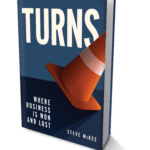Insights
What Turns Can Teach Leaders About the Nature of Business
By Steve McKee
 This article is adapted from Steve McKee’s new book, TURNS: Where Business Is Won and Lost.
This article is adapted from Steve McKee’s new book, TURNS: Where Business Is Won and Lost.
Autumn is a glorious time of year where I live. I remember going for a walk one day along a forest trail under a brilliant blue October sky and admiring the dazzling hues of red and gold leaves clinging to tree branches and strewn along the path at my feet. It occurred to me that the reason I could relish the beauty of “fall” is that I knew that trees shedding their leaves was part of a cycle.
Imagine seeing entire forests turning yellow and branches becoming ever more barren with each passing day if it had never happened before — you’d think the world was ending. But because we understand that it’s part of an annual cycle, the turning of the leaves is something most of us anticipate and relish.
Similarly, many businesses experience seasonality in revenues — retailers make most of their annual profit during the Christmas shopping season, and tax accountants are always busiest in the spring. Knowing this keeps their investors, and their spouses, from panicking.
The science of turns
Thanks to Copernicus and Kepler and Newton and Einstein and many others, we know that virtually everything in the universe is turning, including not only the planets and sun and solar system but the entire Milky Way galaxy as well — all the gas, dust, stars and planets that surround us are spinning at 130 miles per second. The only thing that may not be turning is the universe itself, which appears to be forever expanding, the implications of which are themselves dizzying.
What’s true of the astronomical is true of the atomic. An atom is the smallest unit of a chemical element; it is comprised of protons and neutrons, which together form a nucleus and electrons, which spin around the nucleus as the earth spins around the sun. Technically, electrons are so small and move so fast that we don’t know for sure that they’re spinning, but we do know that they remain in unceasing motion around the nucleus.
Even the DNA molecules found in each one of our cells take the form of a double helix — two strands that wind around each other in an elegant and awe-inspiring spiral, carrying detailed and sophisticated instructions necessary for our bodies to develop, survive and reproduce. It’s no wonder we’re so conversant with turns and turning; the software carrying the very building blocks of life is built around them.
Staying ahead of the curve
The fact that in nature there is no such thing as a completely straight line is a fitting metaphor for why product rollouts rarely go exactly as planned or financial forecasts are never quite accurate. Turns represent discontinuity, a disruption of equilibrium. When margins turn south, there’s a reason. When employee turnover increases, there’s a problem. When the economy shows signs of recession, there’s trouble ahead.
But in many of these cases, a coming turn also spells opportunity — if we’re paying attention. Turns are a signal in the noise. Think of all that humans have invented over the last two hundred years because of what we’ve learned about the principles of turning. Ferris wheels. Sprinkler heads. Food processors. Ceiling fans. Treadmills. Industrial robots. The internal combustion engine. The list may not be endless, but I challenge anyone to complete it.
Much of our prosperity has come as a result of understanding that everything in the universe is turning, from the galactically big to the infinitesimally small. And we have no idea how much the turns we face today have come about as a result of the turns that happened yesterday.
Turns are, truly, all around us, and each has something to teach us. There are events on which economies have turned, inventions by which industries have turned and innumerable turns of fate, turns of fortune, plot turns and table turns that led each of us, often unknowingly, to where we are in our careers and companies. History isn’t history without them, nor is the future the future.
The more I’ve learned about turns, the more in awe of them I’ve become, and the more convinced I am that considering turns can, pardon the pun, keep us ahead of the curve.
TURNS: Where Business Is Won and Lost takes a deep dive into the nature of turns through the lenses of science, history, politics, sports, and more to help you make better decisions in business and life. Get your copy.
Originally published on SmartBrief on Leadership

Steve McKee
Co-founder and author, Steve specializes in addressing the most meaningful problems. Steve’s at his best when you want to change the world. He might even have some books (and some research) on that.
Sign Up for Growth Insights
"*" indicates required fields
Contact
"*" indicates required fields